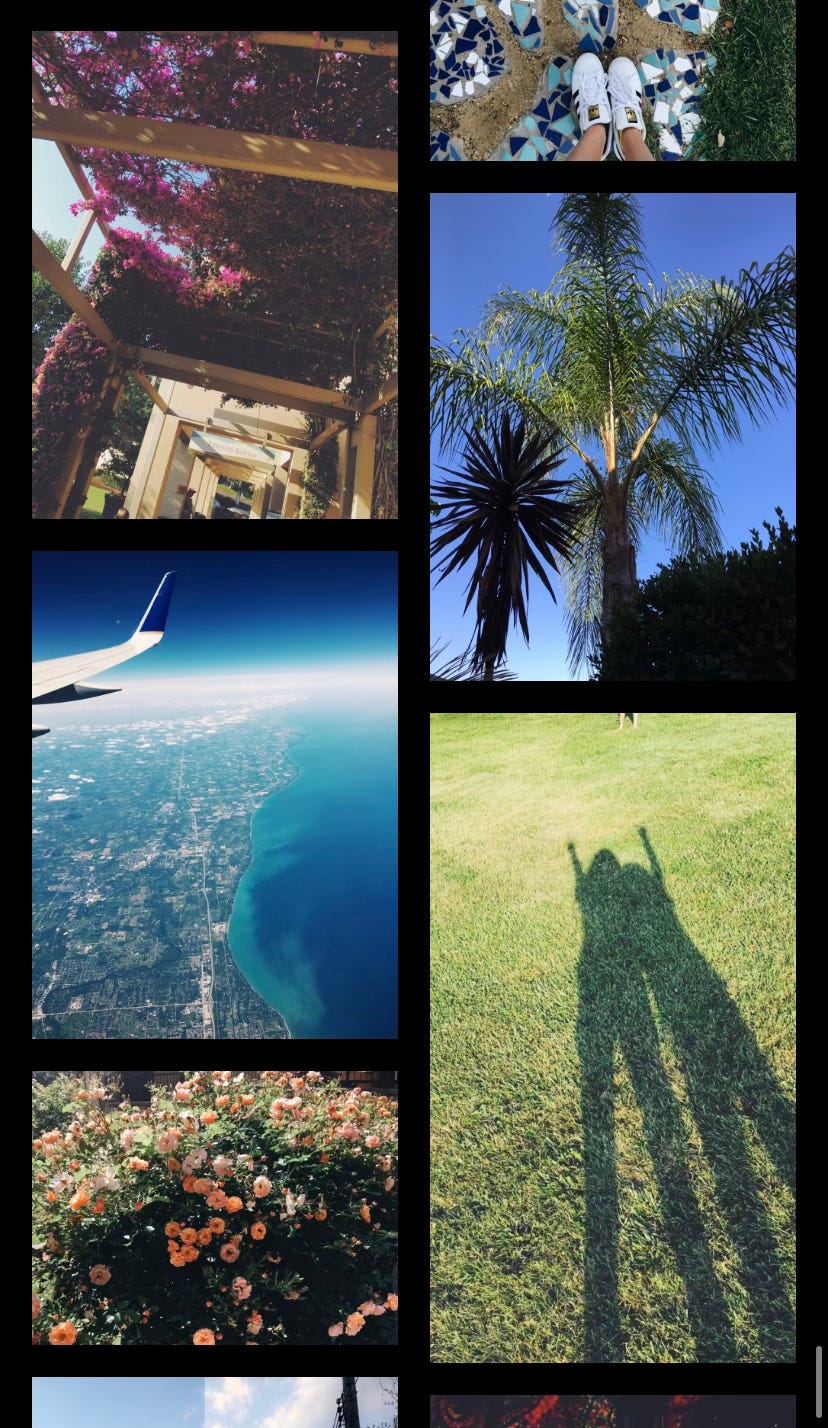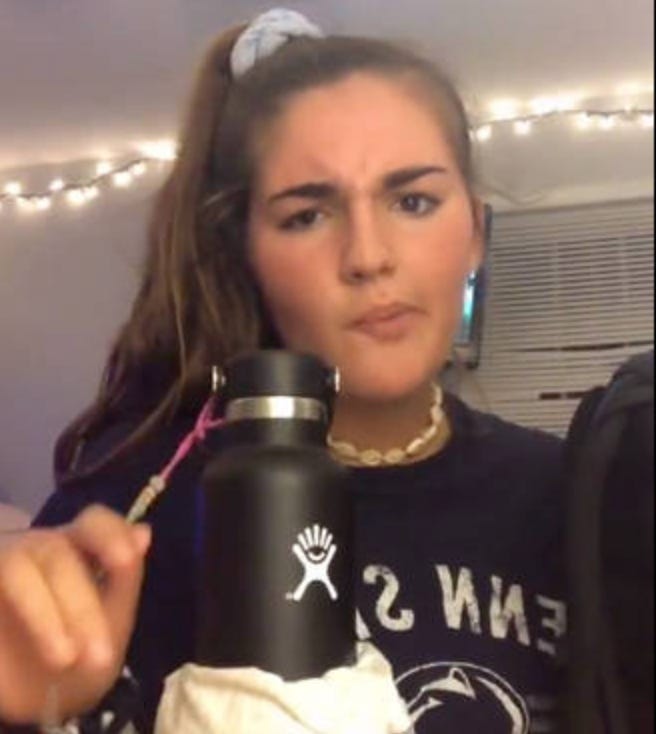O VSCO Girl, Where Art Thou?
Instagram has popularized the “photo-dump,” but what happened to the late-2010s photo app phenomenon that did it first?
VSCO User allidempsey’s feed, circa. 2016
It was late last year when I decided to redownload VSCO again. I was in the middle of my nightly Instagram-stalking session when I saw a vague acquaintance still had her profile linked in her bio. Rolling my eyes, I thought to myself, why doesn’t she just move on like everyone else and make a photodump account on here?
I clicked the link anyway and trudged my way through this girl’s hodge-podge of sunsets, fancy dinners and subtle boyfriend soft launches, I remembered the days in 2018 where 17-year-old me fled to the app to escape a version of Instagram where people still cared about likes. For high school girls of the late 2010s, a VSCO link in the bio acted as their secret door to a beautiful mess of outtakes, where they were free to post the things they wanted without worrying about like counts or post success — just vibes and artistry.
An app originally created for enhanced photo-editing, VSCO was founded in 2011, but didn’t really break into the mainstream until 2018 — when it reached 30 million users. It comes with preset filters and editing tools, and its mostly-wordless, simple interface prioritizes creativity over popularity — a concept slowly inching its way back into the present social media scope.
The 2020s-era mission of “making Insta casual again” has mostly worked. Now that users had the option to hide the like count from their followers, our once-linear focus on high like numbers seemed to have lost its own plot. The majority of people I follow nowadays have opted to churn out day-to-day “dumps,” sometimes on secondary accounts, instead of strictly focusing on deliberate, planned-out photo shoots aimed to score at least 200 double-taps from their peers. As a more realistic, hyper-daily approach to personal storytelling has taken over Instagram, I can’t help but think, didn’t we already have this within the parameters of VSCO?
Apps that center wordless, visual posting have always been present in the internet’s psyche — each online generation thus far has had their own trademark. Whether it's been Pinterest, a Tumblr blog or now VSCO, something about creative, scrapbooking-esque expression with no social gain at stake has always appealed to how we’ve approached our digital footprints.
There was a time when tweenaged me, circa. 2012, downloaded Instagram for the first time on her iPod Touch. She made her icon a stock photo of Spongebob and spammed her five followers with random pictures of art hung up in her home, cicadas in the backyard and over-saturated duck-lipped selfies — not a care in the world about judgment or popularity.
As we grew up on this new social platform, inventing our own metrics and putting value to reception, I was suddenly in the 9th grade, feeling a sense of emptiness when my boomerang of my friends jumping into a pool didn’t hit 100 likes. It felt like the original expressionist confidence and spirit of that thirteen year old girl was lost along the way, falling to the seemingly-inevitable and just plain stupid trap of outside validation.
Then, enter VSCO, stage left. It came to my attention through my high school classmates using it as a sort of “dumping grounds” for content that wouldn’t do well on their other profiles. Most of the photos were things that would probably be included in modern-day photo dumps — food, sunsets, slightly risque photos of a shirtless boyfriend — in a simplistic, diary format unfolding in an endless scroll.
The filters are a lot better than Instagrams — a feature I experimented with greatly (my overused favorite was C1). Sure, you could add a caption, had followers and were able to see who favorited or reposted your flicks, but that info was hidden to the general public. Even then, it didn’t really matter. Who cares if no one “likes” that blurry photo of your dog? It’s a blurb, an outtake, not the real deal — that stuff’s on my Instagram.
TikTok User @koobydoobydoobydoo parodied “VSCO girls” in her viral videos back in 2019.
As the last years of the 2010s progressed, VSCO developed its own personality that reflected off of the people who used it. In 2019, the “VSCO girl” title was born, characterized in TikTok clips by scrunchies, using metal straws to save the turtles and a keyboard-smash cackle of “sksksk.” The trope of the VSCO girl was an artsy bohemian of sorts — carefree and passionate, just like the energy reflected onto the content posted on her favorite app.
Parody videos circled TikTok and other parts of the web, and soon enough, like any trend that embraces the things young girls love, the sealife savior that catapulted VSCO to the mainstream was bashed, trashed and eventually dumped. It’s hard to pinpoint if this trend is what eventually led to the app’s decline, but — looking back at my account’s activity — I started posting a lot less on VSCO around 2020-2021. I can’t help but theorize that through our fears of being viewed as squealing, HydroFlask-wielding high school girlies, we cringed our way out of using it entirely. Thanks, misogyny!
The fall of VSCO intersects with another major shift that occurred in the world of social media during that era. We all moved onto short form videos thanks to TikTok, and also — Reels. The modern day scope of Instagram allows users to stay on the app for both their still and moving content — what’s the point of keeping that separate in the form of two platforms anymore?
Nowadays, in the app’s post-like-count climate, a lot of my friends have started caring less about their Instagram feeds. Secondary IG accounts to post dumps BTS content have become a new normal, highlighting the content that used to go to VSCO. I have one as well, but I have to say — it isn’t the same. I get overwhelmed by the like counts, even if I’m the only one seeing them. I feel like too many randoms follow my spam account still; VSCO always seemed like an online speakeasy where only my closest accolades attended. The minimalism is peaceful to me, and the feeds look prettier — simplistic, sleek and modern. And again, the filters…Instagram’s tacky ones will never do it for me, even if they are named after the world’s greatest cities.
I don’t know why the world moved on from VSCO. It has everything we need, but, at the end of the day, it feels like Instagram will always evolve to overpower these tiny contenders. Even if I can’t start a full-blown movement igniting its comeback, I still post on the app almost weekly, along with my three friends and five high school acquaintances that still use the shit out of it. I shed my scrunchie a long time ago, and no longer laugh in the form of keyboard smashes, but I will always return to my life in C1.






ahhh this took me back to being a teenage in high school and creeping on ppl's vsco's ... Loved it alliiii